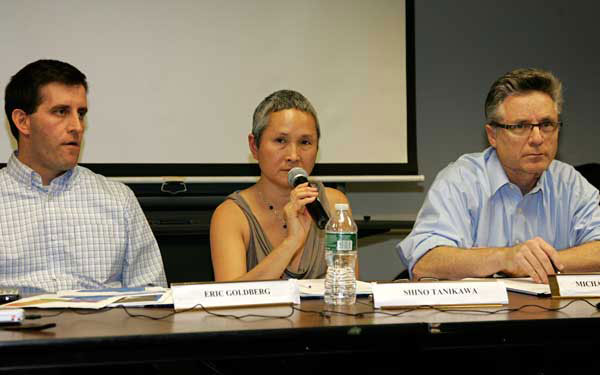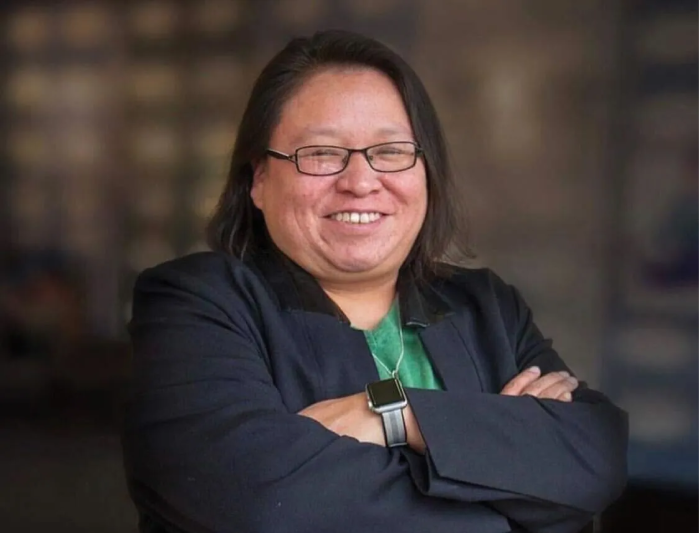
District 2 Community Education Council member Eric Goldberg and Shino Tanikawa, the council’s president in 2012.
BY DUSICA SUE MALESEVIC | The stress-ridden middle school admission process in District 2 lacks any real choice, according to some, and there’s a new idea intended to fix that, but it could strain schools already flooded with applicants.
Eric Goldberg, a member of the district’s Community Education Council for the last four years, said the feedback from parents and administrators has been that the “middle school process is broken.”
District 2 covers much of Downtown as well as parts of the West Side and the Upper East Side.
In order to address the problems with the current admission process, Goldberg said that the C.E.C. has been discussing structural changes but there has no consensus as what is to be done. He no longer wants to wait, he said, to make immediate changes that could help parents and families.
Goldberg has put a resolution that would swap the current model called “revealed choice” to “tiered choice.”
In the current system, a student lists his or her preferences for the middle schools, ranking them first, second, third and so forth. The middle schools are made aware of how the student ranked them, thus “revealed choice.” However, due to overcrowding, many of the most sought-after schools are telling parents they will only consider students who rank them first.
This system has some parents and school advocates calling foul.
“I think that the current system is very unfair,” Eric Greenleaf, a Downtown school advocate, said in a phone interview. “It’s really very capricious too because it says you’re going to get one choice out of all these schools. If you don’t happen to get into the one you put first, then there’s a good chance that you’re going to end up with one that is no where near the top of your list.”
For those students who rank a school first, the acceptance rate is under 40 percent, according to the resolution. Data from the Department of Education’s Office of Student Enrollment for Downtown schools for 2014-2015 mostly bears this out.
Goldberg, the C.E.C. member, said, “That is one of the big imbalances I see in this current system of revealed choice — is that in essence it’s eroding choice in our district. Again, we have to remember that these are 11-year-old kids who are applying to middle school.”
In a “tiered choice” model that Goldberg is proposing, students would still rank the schools, but the schools would only know how they were ranked by tier. Each tier would have four choices, thus tier one would have choices one through four, tier two includes five through eight, and tier three would have nine through 12.
Goldberg says that this will lead to more choice for the student because at least four schools in a tier would consider them.
“For me, the big issue here is that this middle-school — it should be a student-centered process. We need to move away from this fixation on a school-centered process to a student-centered process,” he said in a phone interview.
There is a reason that several popular schools — Manhattan Academy of Technology in Chinatown, East Side Middle School Uptown, I.S. 289 in Battery Park City, Salk School of Science in Gramercy Park, and in Chelsea: Clinton School for Writers & Artists and NYC Lab Middle School for Collaborative Studies — are asking either explicitly or implicitly that students list them first: resources.
Greenleaf emphasized this point, saying that it takes a lot of people and money as well as time to vet all applicants. A former P.S. 234 parent, Greenleaf has conducted detailed analyses of Lower Manhattan’s school population for many years and his children have been through the middle school process.
Shino Tanikawa, president of the C.E.C., said that the resolution is a good starting point for a district-wide discussion but she, too, has concerns about how schools would handle evaluating even more students then they do now.
For example, East Side Middle School had close to 500 applications ranking them first, Tanikawa said in a phone interview. If the school had to look at candidates that ranked them just first and second — like under the new idea — it could maybe face reviewing 1,000 applications, she estimated.
“It’s really a matter of how many applications can they possibly review without compromising their first priority of serving students who are already in the middle school,” she said.
Tanikawa said that several schools conduct interviews, review student portfolios and projects in a group setting — things that require quite a bit of time, thinking and planning.
While the C.E.C., made up of parents, has had discussions with the middle school principals, Tanikawa said that the current resolution needed more input from them and what kind of impact changing the system would have.
“For us to move forward with this resolution, the first step has to be can the principals manage this? Because they’ve already told us they couldn’t, so is there a way for them to manage this,” she said. “And then collectively come up with a solution that serves not just the families but also the middle schools.”
Principals of M.A.T., I.S. 289, Lab and Salk declined to comment for this article.
When asked about the resource crunch, Goldberg said that many schools use interviewing as a screen to maintain school culture and he questioned its efficacy, calling it the “least objective measure that’s out there of students.”
“If someone is asking us to say that we should basically eliminate choice for students so schools can meet with students for 15, 20 minutes — that’s not the tradeoff I’m willing to make,” he said.
Greenleaf, the Downtown school advocate, said that middle schools have challenges when it comes to assessing a student because they have less data to go on than high schools, which have G.P.A.s and test scores.
“That means really there’s more demands put on the middle schools compared to the high schools for every student that they need to evaluate,” he said. “And so there is more of a need to bring children in for interviews, to create their own tests based on what their school is about and administer it to the kids.”
Tanikawa said a change in the process may have consequences that parents need to be aware of.
“I’m afraid what might happen if we force this on middle schools is that they’re going to be put into the corner,” she said, “and they’re going to have to figure out a way to either narrow the pool of candidates that they can have their qualitative assessments on…
“Or they may decide not to use any qualitative assessments and strictly focus on attendance, grades and test scores — or they may decide not to screen at all and maybe randomly select students.”
It is clear that the middle school process is a complicated one. Goldberg wants to have a more transparent system, encouraging the schools to share information, such as the profile of a typical student — average test scores and grades — that gets admitted, with parents.
Tricia Joyce, co-chairperson of Community Board 1’s Youth and Education Committee, recently completed the application process for her twin daughters and found it overwhelming, difficult and time-consuming.
“No parent has enough information about what schools would accept their child and so they’re making this as a blind choice really,” she said. “Further exacerbating the issue is that if you don’t guess right, there is a good chance that you then slide all the way down the ladder of your supposed choices to your zone catchment school.”
For Joyce, the root of the problem is overcrowding due to a lack of infrastructure.
“I think that if you don’t build enough schools, then the schools are faced with 800 to 1,000 applications for 120 spaces,” she said in a phone interview. “At that point they are doing what they can to manage parents’ expectations.”
For example, she said, P.S./I.S. 276, a K-8 school in Battery Park City, told parents upfront that they had only nine seats open for their sixth grade as its current fifth graders are taking the majority of spots.
An increase in population in Lower Manhattan led to a kindergarten crisis in 2008, where there were eight kindergartens at P.S. 234 — a school built for five classes, said Joyce. At the time, there was a scramble to get elementary seats with many saying don’t forget about middle school.
“Whenever you have a tsunami to your left and you have a tropical storm to your right, you’re going to try to deal with the tsunami first,” she explained, comparing middle schools to the storm. “But the tropical storm is definitely going to be there, it’s not going to go away.”
The resolution will be discussed at the upcoming C.E.C. meeting on April 20 at 6:30 p.m. at 333 Seventh Ave. and parents and the community are encouraged to attend, said Goldberg. If it passes, it will then go to the D.O.E. admission office, which will have the final decision on implementing the tiered choice model.
Goldberg said the D.O.E. has been enthusiastic about the model, but wants to see community support for it. If the D.O.E. does move forward, it will affect the 2016-2017 school year, he said.
“We value parental input and are constantly working to engage families in their students education,” said Yuridia Pena, deputy press secretary for the D.O.E, in an email. “Community Education Councils are integral to shaping education policies and we continue to work with parent leaders to gain feedback that will improve our policies.”
Leo Contrastano lives in Tribeca and is a current fifth grader at P.S. 41 in the Village. He hopes to attend Lab for the upcoming year. When he heard about the possible change through his mother, Jessica, she said in an email that he likes the idea of having more choice, but didn’t like having to test for four schools — or the prospect they might all take place in one week.

































